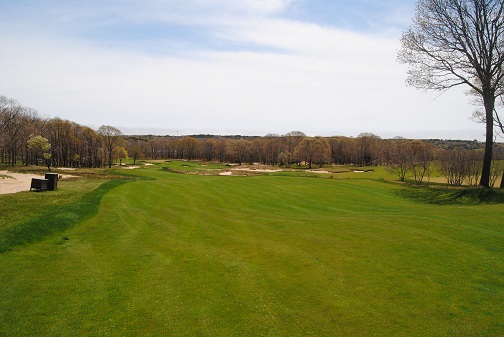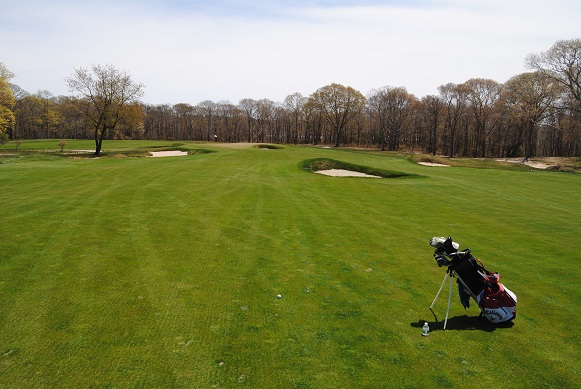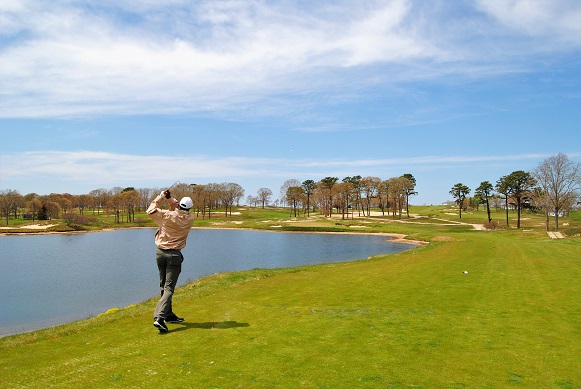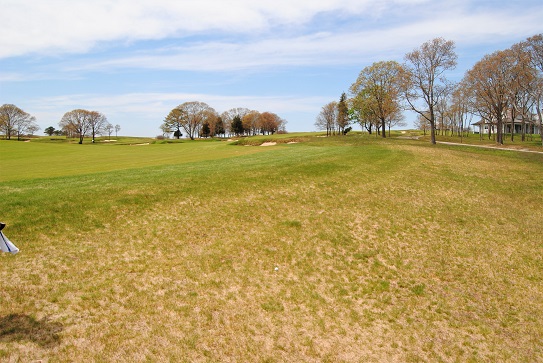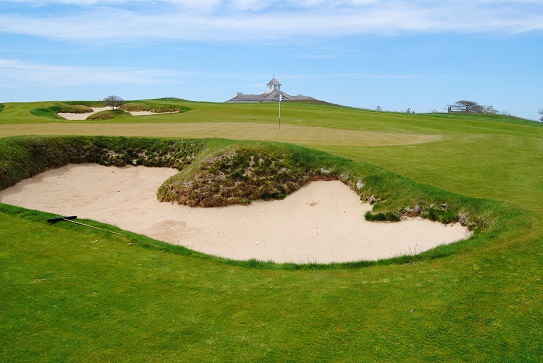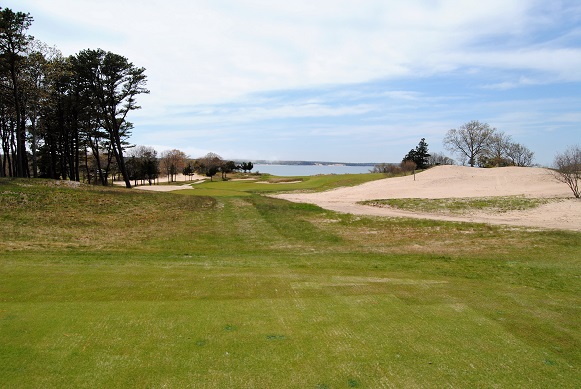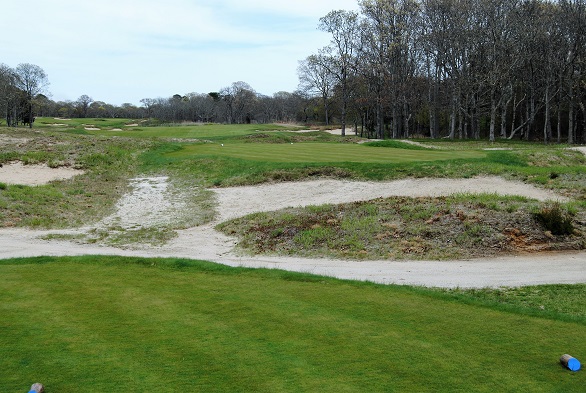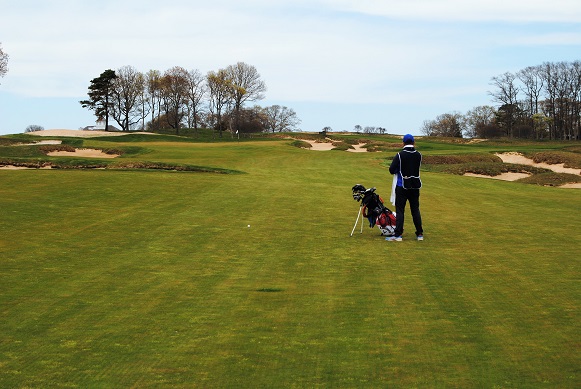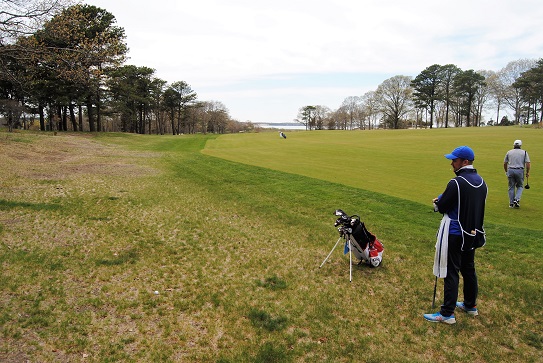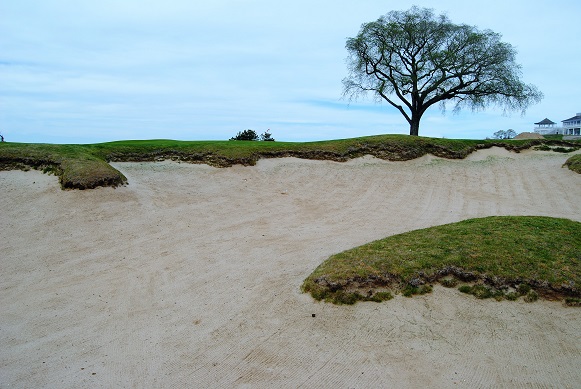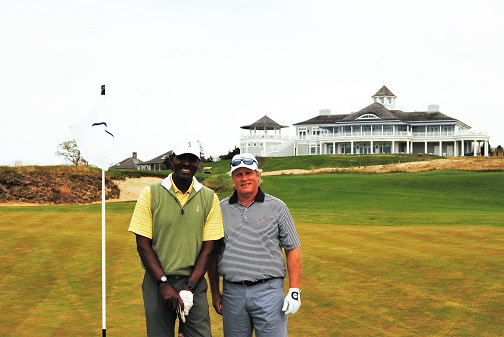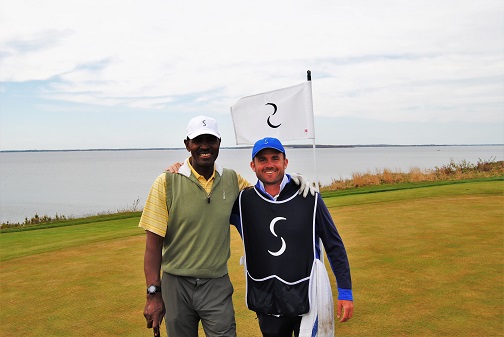Following my round with Bob at a top 100 private course in the Bay Area, he asked if there were other courses I could use some help with. Bob is a member of my home course in Atlanta, Cherokee Town & Country. He and I played together occasionally at our club. He is also the person who introduced me to Keegan. Keegan in turn introduced me to Jeff, who introduced me to JFK. JFK hosted me at Calusa Pines.
The conversation with Bob following our round in the Bay Area back in February led to an introduction to Dave, a member at the Sebonack Golf Club. Dave and I exchanged emails and then talked over the phone about the timing for playing a round together at Sebonack. I told Dave that I was planning to play all the Long Island courses during the second week of May. Dave expressed concern about the weather. He said that temperatures on the eastern end of Long Island could linger a month behind the western end but said he would be happy to play whenever I wanted. We agreed to play it by ear.
As I started to fill out my May schedule with firm tee times for the other courses in the Hamptons, I contacted Dave and firmed up our tee time for the second week of May. On a beautiful Spring morning, I drove from my hotel in Riverbend to the Sebonack Golf Club. Dave was already there when I arrived. He saw me and came over to introduce himself and our caddie, Joe. Joe was from Long Island and has been caddying at Sebonack since 2006.
Sebonack was the first of the many Top 100 courses that I was to play that in the Hamptons on Long Island. Prior to beginning my quest, I’d never heard of Sebonack. It is located next door to National Golf Links which is situated between it and Shinnecock Hills. I had built my entire Hamptons schedule around playing Shinnecock Hills on May 12th. A week prior to my scheduled rounds in the Hamptons, my Shinnecock host had to regrettably cancel due to a death in the family. I was now scrambling to find another host. This was made more difficult by the timing of the cancellation and restrictions on guest play that were required to prepare the course for the U.S. Open.
As I prepared to play Sebonack, I still didn’t have a new host for Shinnecock. It was tantalizing to peer beyond National Golf Links and see Shinnecock. I was so close yet so far. There were several people assisting me with identifying a Shinnecock member who still had quest privileges and could host me, but no one had been firmed up. I had to set those thoughts aside for now and focus on my round at Sebonack.
Sebonack has an interesting history. It was designed by Tom Doak and Jack Nicklaus, together but separately. I think they each may have designed a golf course that was later combined into a single 18 hole course. It wasn’t clear to me how much they actually collaborated. In either case the result is a course that is rated by Golf Digest as one of the Top 100 Courses in America and thanks to Bob and Dave, I was here in early May to play it as the 74th course in my one year quest to play all 100 courses.
Dave, Joe, and I headed over to the driving range to warm up prior to our round. I’d played 19 holes the day before after flying from Atlanta to New York. Following those 19 holes, I drove to Bridgeport, Connecticut and took the ferry from Bridgeport to Port Jefferson. I arrived at my hotel in Riverhead, just west of the Hamptons and got a good night’s sleep. My body felt good and the swinging was easy. I felt good about my warm up.
Dave and I decided to play from a combination of the Blue and White tees. The combination measures 6640 yards with a rating of 73.2 and a slope of 136. I think we played from the Blue tees on the vast majority of the holes. I think our actual distance played was closer to 6800 yards.
The first hole at Sebonack eases you into the course. From the Blue tees it measures 337 yards. The fairway starts out very narrow but widens in the landing zone. There are trees along the right side of the fairway and a hill with thick rough off the left side. The hill slopes toward the fairway. Bunkers cut into the fairway from the left and the right at a little over 230 yards from the tee. I hit my 5 wood off the tee. I popped the ball up to the right. It landed in the right rough but with a clean lie.
My short tee shot left me with 170 yards to a back right pin position on a green with a bunker off the front left and one off the right. I hit my seven iron toward the flag, but the ball faded. It flew the right greenside bunker and landed in the rough to the right of the green.
I thought I had an easy chip to the green but quickly learned that the sandy soil played more like a bunker shot than a chip. I left the ball in the rough on my first chip. My second chip made it to the fringe to a foot right of the hole. I tapped in to start my round with an unfortunate double bogey, but an important lesson about the ground around the greens.
The second hole at Sebonack is along the water. The first thing that came to my mind as we stood on the tee box was, my god there are a lot of bunkers out there. They looked too numerous to count and to avoid. The hole measures 420 yards from the Blue tees. The fairway is wide and not very defined. I hit a 245 yard drive to the fairway. I wasn’t sure how I did it, but I avoided all the bunkers.
I was left with 172 yards to a back left pin position. There were several more bunkers between my ball and the green. The green has a bunker and a slope with rough and trees off the right side and two bunkers off the back left. I pushed my approach shot way right. The ball bounced into the trees.
My ball was close a tree, my only shot was a chip to the greenside bunker.
My bunker shot flew over the green. I chipped back to three feet of the cup and made the putt for my second double bogey. Just two holes into my round things were looking a little dim. I’d managed to find a way to turn what should have been two pars or at worst two easy bogeys into easy double bogeys.
Things improved little on the third hole. The hole is a 384 yard par four from the White tees. The fairway is wide but from the tee box it looks very narrow. It slopes right to left and doesn’t have as many bunkers as the fairway on the second hole. Two of two it does have in its left side are problematic if your ball lands in them. I was able to avoid these bunkers by hitting a 235 yard drive to the right side of the fairway, leaving 160 yards to a far left pin position on a very wide green.
The green is uphill with a bunker in front. With the pin on the far left, I tried to hit a draw around the bunker. My six iron shot drew but not nearly enough to get close to the flag. I was left with a very long birdie putt.
I left my birdie putt ten feet short of the cup and then missed my par putt. I wound up with a three putt bogey. I’d hit two fairway, barely missed another, hit one green in regulation and just missed another and yet I was three holes into my round without a par. On the brighter side, I’d hopped off the double bogey train.
As we left the third green and headed to the fourth tee box, the golf course superintendent, Garret Boddington stopped by. With do one pressing us, we had a moment to chat about the course and how it was set up. Opportunities like this always add to my experience at a course.
The fourth hole is the first par three on the course. From the Blue tees it measures 205 yards. The hole plays downhill to a very large green. There is a long bunker about 10 yards before the front of the green and two each off the left and right sides of the large two-tiered green. The flag was position to the left on the lower tier. I hit my 5 hybrid to short of the green leaving 35 yards to the flag.
I chipped onto the green to 15 feet below the hole. I missed my par putt and tapped in for a bogey.
The short 335 yard par four fifth hole has another bunker infested fairway, but also has a generous landing zone. One of the bunkers is however in the middle of that landing zone at about 250 yards out. I hit my drive 235 yards right at the bunker.
I was left with 105 yards to a middle pin on a green with a bunker off the front right and one along the left side. I left my sand wedge approach just short of the front of the green.
I caught my chip a little thin. The ball rolled off the back of the green. I putted back onto the green and made the next putt for yet another bogey. I was now through five holes and still hadn’t recorded a par. I had two doubles and three bogeys.
The sixth hole has one of the narrowest fairways on the course. There are bunkers off the left and right sides at 250 yards from the Blue tees. There is also a bunker off to the right at 100 yards from the green. The green is offset to the left of the fairway at a 45-degree angle. I hit one of my worst drives of the round. I sliced the ball to the trees between the 6th fairway and the 8th fairway.
I was left without a direct path to the green. To make matters worse, there was a clump of grass behind the ball. To safely hit to the sixth fairway, I would have had to pitch out back toward the tee box. Joe thought it would be better to pitch out to the 8th fairway. He provided me with a line and distance which would leave me with a clear shot to the green. I pitched to the 8th fairway and was left with a 135 yard unencumbered shot to the green.
My third shot landed just short of the green. I chipped on to four feet and made the putt to save bogey.
On the par four seventh hole we moved up to the play from the White tees for only the second time on the front nine. The hole measures 412 yards with a very interesting fairway. It is offset to the left of the tee box but angles back toward it. At about 280 yards out, it angles back away from the tee box and toward the green. There is a bunker cut into the right side of the fairway as it makes the turn and two on the right on the inside of the turn. There are several additional bunkers on the left that are in the deep rough through the green. There is also another bunker that cuts into the right side of the fairway at about 80 yards from the green. I hit my drive down the right part of the fairway to just left of the bunker at the turn.
My drive left me with 185 yards to back left pin position. The shot was playing 210 yards dead into the wind. The green has bunkers along the left and the right sides. I hit a 3 hybrid to few feet off the left edge of the green.
The pin was on the back of the green on a lower tier. I putted from off the green and let the ball ride the ridge. It rolled to 5 feet. I made the putt for par. It was my first par of the round. After double bogeys on the first two holes, I ran off four bogeys in a row. If I were taking an IQ test that asked what the next set of numbers in the series would be, I would have to answer 8 pars – 2 doubles, 4 bogeys, 8 pars. Makes sense, right? Well let’s see if I can do it.
On the par three eighth hole it was time to return to the Blue tees. They were moved up a little and playing 155 yards. While there is fairway to the right, the hole plays completely over water to the green. The pin was sitting on the upper tier at the back of the green. I hit an 8 iron to 45 feet below the flag and to the right. I was just left of the greenside bunker.
I hit my putt 44 feet and six inches. I tapped in for my second par. Two down and six more to go to continue to pattern.
The front nine ends with a 532 yard par five from the Blue tees. It is another hole with a wide fairway but one that has a few bunkers to offset that generosity. Off the tee the most troublesome bunker is the large one that is in the left half of the fairway at 250 yards out. There are also bunkers off the fairway in the same vicinity off the left and the right edges. To avoid the bunker in the left half of the fairway, I hit my drive down the right side. The ball flew the bunker off the right side of the fairway and landed in the rough at 260 yards from the pin.
There were even more bunkers to contend with on the second shot. There was one on the right at 80 yards from my ball which I didn’t worry about. The one I worried about was the one on the right that started at 150 yards from my ball and continued to 200 yards from my ball. The smart play would probably have been to lay up short of the bunker, but that would leave 140 yards to the green. Another option was to lay up to 100 yards, but then that bought a bunker on the left side of the fairway into play. In the end I decided to hit my 3 hybrid over the bunker to leave a 50 yard pitch shot to the flag.
Fifty yards is my favorite distance to pitch from. My shot almost cleared that bunker I was concerned about. But this ain’t horseshoes. Almost doesn’t count. The ball hit the lip of the bunker and kicked back in. This left 115 yards from the bunker to the pin rather than a nice comfortable 50 yard pitch from the fairway.
My third shot landed in the right greenside bunker. I hit my bunker shot to 20 feet and made the putt to save my par and extend the string to three pars in a row. After the bad double bogey, double bogey start I’d rebounded to shoot a 43 on the par 35 front nine.
The back nine starts with a 361 yard par four from the Blue tees. The fairway slopes right to left and is extremely wide once it gets beyond a fairway bunker cut into the right side at 200 yards out. There are other bunkers but with such a wide fairway, none should be in play after the tee shot. To stay away from the bunker on the right, I hit my drive to the generous left half of the fairway, leaving 135 yards to uphill green almost blind and disproportionally small green compared to the width of the fairway.
The 135 yard shot was playing 150 yards. I hit an eight iron to 18 feet right of the pin. As we walked toward the green to a higher elevation, I could see Shinnecock Hills across the way. Without a definitive tee time at this point, I was again so close and yet so far away. It was like having a thirst in an ocean with water everywhere but not a drop to drink.
I put the thoughts of Shinnecock out of my head again and focused on my makeable birdie putt.
I hit the putt on line but committed the cardinal sin of leaving it one foot short of the cup. My par streak was now at four. I was halfway there.
The eleventh hole is the longest par four on the course and the second most difficult hole on the course. It plays along the water. I mentioned earlier that Sebonack, National Golf Links, and Shinnecock are all right next to each other. Sebonack is the only one of the three courses with multiple holes that play along the Great Peconic Bay which is just off Long Island Sound.
This long par four measures 463 yards and requires a carry of 170 yards from the blue tees to reach a fairway that is narrow in most spots but wide in the landing zone. There is a bunker in the left half of the fairway at 220 yards from the tee. From the tee, the fairway is not visible beyond that bunker. I hit a massive drive that cleared the crest in the fairway and must have rolled for days.
We couldn’t see where my ball ended up until we cleared the crest as we walked toward the green. From there we could see that it was in the fairway. There was 165 yards remaining to a middle right pin on a green that was downhill from us and protected by bunkers on the left and the right.
While the green was downhill, it was playing 170 yards into the wind with the Great Peconic Bay in the backdrop. I hit a six iron to the right side of the green, just left of the bunker. The ball rolled off the green to the right but stopped before it reached the bunker.
I putted from just off the green on a line toward the center of the cup. The ball ran out of steam two feet short of the cup. I’d now left two birdie attempts short. I made the two-footer for my fifth consecutive par. The number one handicapped hole on the course ate my bacon when I hit my approach shot to the right and had to chip into the bunker. I extracted a little revenge with an easy par on the number two handicapped hole.
You would think after conquering the second most difficult hole on the course, the easiest hole on the course and the shortest par three would be a piece of cake. The hole measures just 152 yards from the Blue tees. There is a carry over vegetation to a well-protected green. There is a large bunker in the front of the green and one off each side.
Joe and I talked about this being an excellent opportunity for me to get that elusive hole-in-one that I hadn’t gotten during my Quest. I’ve made two hole-in-ones during my fourteen year golf career, but none during my quest. The pin was positioned on the upper tier on the back of the green. There was a slope on the left that ran toward the flag. Joe told me that if I could land the ball pin high on that slope, it would roll down toward the hole.
I thought I was aligned just left of the flag, but my ball flight indicted differently. I hit my ball straight, but it landed in the bunker just left of the slope I was trying to hit. That meant that my alignment was off.
Joe said a bunker shot to that same spot where I intended to hit my tee shot would still send the ball directly to the hole. I missed the spot by a foot to the right. The ball rolled down the slope to 10 feet below the hole.
I missed my par putt and my string of pars came to an end at five on the easiest hole on the course.
Licking my wounds, we made our way to the 529 yard par five 13th hole. The fairway starts out narrow but widens in the landing zone. There is a bunker on the right that cuts into the fairway at 220 yards from the tee. There is another one that comes in from the left thirty-five yards further up the fairway. I hit a line drive tee shot short and to just off the right side of the fairway.
With such a short tee shot, I thought I had an excellent opportunity to hit my driver from the rough. I had 150 yards to the bunker that cut into the left side of the fairway and 256 yards to a pond on the right. I thought a nice fade off the bunker on the left would leave me short of the pond with 180 yards to the middle of the green. The only problem was the little clump of grass behind the ball.
Sure enough that clump of grass affected the ball. The ball didn’t fade. It stayed straight. Fortunately, it only traveled 145 yards and stopped just short of that bunker on the left leaving 270 yards to the middle of the green.
I laid up with my third shot to 115 yards out. My fourth shot landed in the left greenside bunker. I hit onto the green with my fifth shot and two-putted for my first double bogey since the second hole.
After a double bogey on the last hole, I tried to stay focused on making good swings. I didn’t want to repeat my actions on the front nine that led to back to back doubles. We moved up to the white tees on the par four fourteenth hole. The hole measures 405 yards from the white tees. The fairway is wide but framed by lots of bunkers, especially off its right side. I didn’t catch my drive well but hit it to the middle of the fairway. I avoided all the bunkers on either side. I was left with 185 yards to the pin on the front part of a green with sand along its right side.
While I was 185 actual yards out, it was playing 195 yards. I hit a 5 hybrid to just right of the pin. Unfortunately, the green sloped left to right so the ball rolled further right to 30 feet from the hole.
I hit my birdie putt too hard and through the break. I made the comeback putt for a par and felt good about not letting my round get out of hand after the double bogey on the 13th hole.
The par four 14th hole separates the two par fives on the back nine. We moved back to the Blue tees on the par five fifteenth hole which measures 580 yards. The tee box is almost at a 90-degree angle to the vast majority of the fairway’s length. The fairway makes a hard turn to the right at 270 yards from the tee box. The only fairway bunker on the hole is on the right side of the fairway as it makes the turn. The trees that line both sides of the fairway are about the most tight and thick ones on the course. I pulled my drive short and to the left into the rough leaving 400 yards to the middle of the green.
Just like on the on the thirteenth hole, I tried to make up ground my hitting my driver out of the rough. Just like on the thirteenth hole, I caught to many patches of grass first. The ball traveled just 150 yards and remained in the rough.
With 250 yards remaining to the green and nothing but a bunker just short and to the right of the green to worry about, I hit my three wood for my third shot. I hit the ball fat and it flew just 115 yards leaving 135 yards to the flag which was position on the right in the middle of the green. There were bunkers on the right and off the back.
I left my fourth shot short of the green. I chipped on and made the putt to save bogey.
The sixteenth hole is 426 yard par four from the White tees. It has a wide fairway with trees along the right side along with a bunker at about 235 yards from the tee. The left side is more open but does have a cluster of trees at about 230 yards out from the tee box. I pulled my drive way left in to the sand short of the cluster of trees at 230 yards from the tee box.
The trees were now on a line between my ball and the green. I attempted to hit a pitching wedge over the trees and back to the fairway. I didn’t pick the ball cleanly and it came out with a slightly lower trajectory than expected. Rather than flying over the trees, it went through them proving that they were 90% air. The 10% that wasn’t air slowed the ball, so while it made it to the fairway I was still left with 160 yards to the pin.
My uphill 160 yard shot was playing 170 yards. I hit a six iron to 18 feet left of the flag.
I missed the par putt but was happy to make bogey after such a poor drive.
The seventeenth hole is the final par three on the course. It measures 183 yards from the Blue tees but was playing more like 170 yards. The hole is almost all carry over sand and rough to a green with a bunker off the front left and two behind it. I had a bit of bad luck on the hole. My tee shot hit a sprinkler head just in the fringe on the right side of the green. The ball kicked backwards and rolled down the front green and into the front bunker.
The golf gods must have felt guilty about that because my next shot went way beyond my level of golf skills. I hit my sand shot to six inches and tapped in for a sand save par!
The finishing hole is a 544 yard par five from the Blue tees. The tee box sits high above what looks like a narrow fairway. That’s only because the left edge of the fairway slopes off into the Great Peconic Bay. There is plenty of room to the right. There are bunkers on the right starting at about 270 yards from the tee. I hit my first drive to the left. Dave said that he wasn’t going to let me end on that type of drive. He said hit another one. I popped that one up to the right. He gave me a ball and said I was going to keep hitting until I put one in the fairway. I put the third ball in the fairway.
My first ball probably went down the slope toward the Great Peconic Bay, my second ball would have been playable, but we forgot about both of those and I just played the one from the middle of the fairway. That one was about 280 yards from the middle of the fairway.
The biggest concern on my second shot was a rather large bunker at 120 yards from the green. I attempted to hit over the bunker rather than laying up short of it. My ball fell a few yards short of clearing the bunker.
I hit my third shot short and to the right of the green. I chipped to 18 inches from the pin and made the putt for a generous par. Generous because of the mulligans on the hole. With that mulligan assisted par I finished the back nine with a 42 for a total score of 85.
Following our round Dave gave me a tour of the clubhouse and treated me to drink (coca cola of course) while we talked golf and chatted with the pleasant and friendly staff at the bar, Kelley from Ireland and Lindy from South Africa. I’d like to thank Bob for the introduction to Dave and Dave for hosting me at Sebonack.














